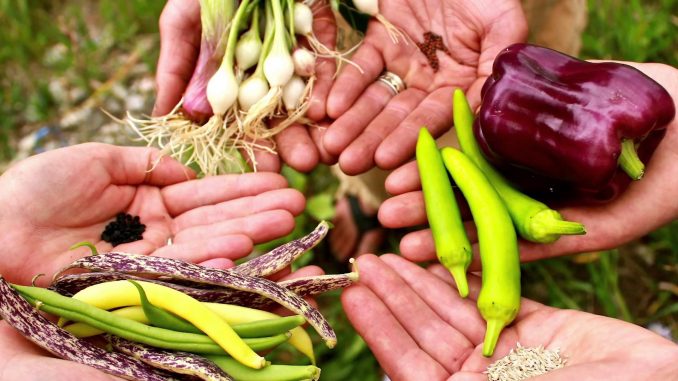
By TS Sudhir
Chakri Bai of Arjunnayak hamlet near Zaheerabad in Telangana cannot help teasing the assembled crowd which has travelled 120 kilometres from Hyderabad. “You people are not able to withstand this mild sun even for a while, you have already become shrivelled. But barring a two-hour break during the day, we women farmers are in the field from dawn to dusk. We can withstand it because of the food we eat. You people are like broiler chicken, we are like country chicken,” said Bai.
Saturday was a special day for Bai and 250 farmers like her. She was part of a signing ceremony between farmers and consumers where cultivators pledged to give customers a basket of produce every year for a certain amount of money. This is the first time in India that a group of urban consumers have decided to look beyond organised markets for organic food and decided to partner in the production process with farmers. The financial support from the 100-odd customers will also reduce the dependency of farmers on money lending agencies and state sops.
Two packages are on offer: Rs 25,000 and and Rs 12,500. As part of the plan, six varieties of grains, four varieties of pulses, two kinds of oilseeds and jaggery are provided at periodic intervals. For instance, the Rs 25,000 package includes 24 kilograms of flour made from jowar/bajra, 30 kilograms of ragi rava, 40 kilograms of tur dal, 40 kilograms of green moong dal, 25 kilograms of urad dal, 8 kilograms of jaggery and much much more. Under the Rs 12,500 package, you get half the produce.
“What I am conveying by part of this bond is that I am with my farmer,” said Telugu TV host Jhansi Rani. “And I am not looking at it as a capital investor from which I want returns. The idea is not to approach this with a consumer mindset but that of a supporter who also desires a change in lifestyle.”
In fact, that is the hidden agenda. At a time when fitness challenges are taking the virtual world by storm, the idea is to make India healthy. That Indians should cut down on consumption of rice and wheat and shift to more healthy grain options, which are also not input resource intensive, in terms of water and fertilisers. So, this pact is not just about putting money in the pockets of farmers, but also about making a promise to lead a more healthy lifestyle by changing breakfast, lunch and dinner options.
“Frankly, farmers could have done with just one or two varieties of grain or pulses, and pledged to provide that to the consumer. But then the idea is to transfer our biodiversity of agriculture, the multiplicity of crops to the table as well and provide an escape route for the consumer who has been fed only cheap rice,” said PV Satheesh, director of the Deccan Development Society (DDS). The memorandum of understanding is the brainchild of the DDS.
What this pact means is that these select consumers have understood the soul of agriculture, and they are understanding the process instead of merely receiving the product. And over a period of time, it will hopefully lead to personality changes, understanding of issues, empathy for farmers and respect for land and crops.
“It is an effort to move from feeling good about buying organic foods to feeling better that you have supported that as a lifestyle. This was long overdue,” said Vinod Pavarala, professor of communication at Hyderabad University. “This will also lead to an alternative socio-economic model of agriculture, with consumers picking up a greater stake in it through this expression of solidarity.”
The overhead is less, which means farmers will not get pushed into a debt trap. The seeds they use are indigenous, passed down through generations, with the women of the community deciding what works best in different conditions. In the past 30 years that DDS has been working with farmers, there has not been a single agrarian distress-related suicide in these parts.
The irony is that just a few kilometres away in neighbouring Medak and Warangal districts, several hundred farmers take the extreme step every year. When it comes to farmer suicides, Telangana figures in the top three states. The big difference is that farmers here, largely women who call themselves millet sisters, have not lost their spirit for agriculture. How different is this pact from the K Chandrasekhar Rao government’s decision to give Rs 8,000 per acre to the farmer every year to reduce his dependence on external lending agencies?
“Any rupee put into farmer’s pocket is important,” agreed Satheesh. “But the question is: Through this incentive, what kind of farming are you encouraging? What we are seeing now in most parts of India is toxic agriculture: Pushing poison into the soil with no respect for the earth. The support has to be more nuanced, you cannot put the millet and the cotton farmer on the same page.”
As Mallamma, her husband and daughter plough their field ahead of sowing, they hardly look skywards. The family is not unduly worried about the monsoon playing truant. Though farming in this part is largely rain-fed, they are confident their different 15 to 20 varieties of seeds can survive even in a stingy monsoon season. Other varieties will survive even if there is a downpour, providing them with an insurance cover of sorts. Confident they now have the consumers’ backing, they want to ensure this model of community-supported agriculture tastes success.
Source: Firstpost

Leave a Reply